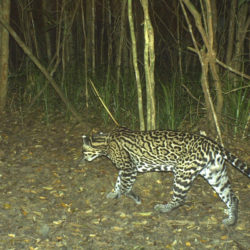
Cats at Runaway Creek
Jaguar
Across the planet large cats have inspired legends, superstitions and myths. The jaguar has dominated cultures and religions of two continents. The Ancient Mayas believe he is the Sun God Kinich Ahaw, and during the night he had the power to go to the Upperworld and the Underworld. The jaguar was a sign of royalty and power.
Within the last 60 years, the jaguar’s range was markedly reduced, receding southward from the US and Mexico about 1,000 km. and northward about 1,500 km. Across its range, the major threats include habitat fragmentation, competition with humans for food and living space and persecution by humans.
Dr. Alan Rabinowitz was the first to conduct a study on the jaguar in Belize, with radio collars, leading to the establishment of the Cockscomb Basin Wildlife Sanctuary. Dr. Omar Figueroa conducted the first telemetry study of the jaguar at Runaway Creek Nature Reserve.
Individual jaguars can be identified by their roseate patterns! They are powerful, solitary cats but shy from humans.
Puma
The cat with many names! Puma, cougar, mountain lion, panther, red tiger…. This is the cat with the largest geographic distribution, adapting to different habitats. The puma has been documented in 28 countries in the Americas, and also has its fair share of legends. The population and range are being affected by habitat loss and human conflict.
The individuals are difficult to identify due to their solid colored reddish fur. Eight pumas were GPS collared by Dr. Omar Figueroa at Runaway Creek Nature Reserve.
Ocelot
The ocelot is Belize’s second smallest spotted cat. This small cat is so difficult to see in the wild, their presence is documented mostly by trail cameras. This mostly terrestrial cat is active at night. There has been no in-depth study of the ocelot in Belize.
Margay
The smallest spotted cat of Belize, the margay is mostly arboreal and active at night. During the day it sleeps in trees 7 to 10 meters high. It feeds on small rodents, opossums and birds. Unlike other cats, the margay can partially rotate the hind feet and run down trees head first! The margay does not adapt well to habitat alteration, and very little information is available for the margay.
Jaguarundi
The two jaguarundi morphs, dark gray and reddish, can be found in Belize. This small, plain colored cat favors areas with dense, low cover near water, scrub forest and agricultural areas but is less common in deep forest. It is mostly active during the day. The jaguarondi occupies large home ranges – 100 sq. km. for males and 20 sq. km. for females (Konecny, 1989). They feed mostly on anthropods, rats, lizards, rabbits and birds.









